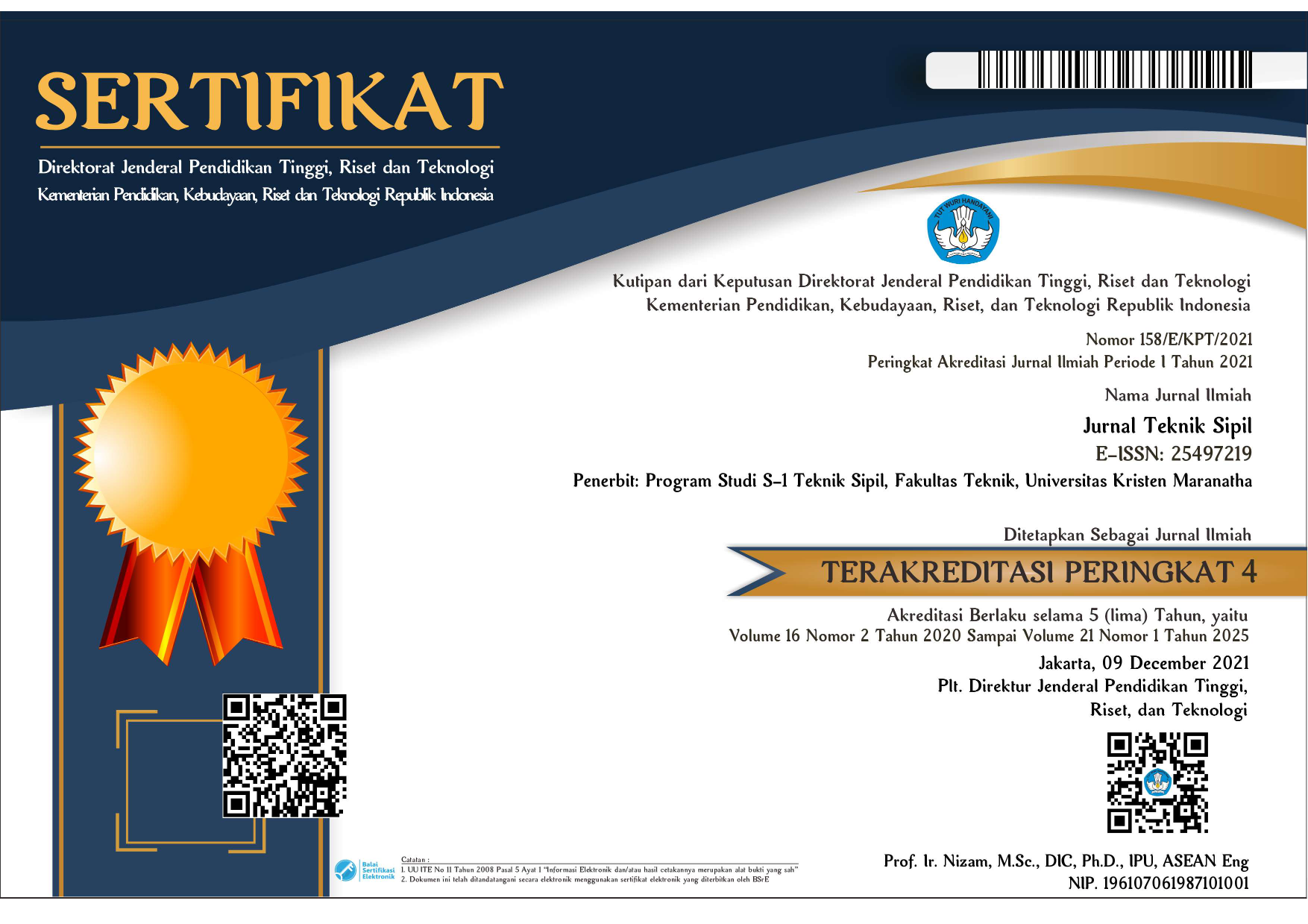WASTE MATERIAL ANALISYS WITH THE IMPLEMENTATION OF LEAN CONSTRUCTION
DOI:
https://doi.org/10.28932/jts.v18i2.4494Keywords:
Pareto Diagram, Lean Construction, Bayes Theorem, Waste MaterialAbstract
Waste material affects project implementation. In addition, it also affects the productivity of the project as well as costs and time. Based on this, good management is needed in handling and minimizing the occurrence of material waste. Lean Construction is one approach that can be used to handle and minimize this occurrence. This study aims to determine the most dominant waste material indicators that cause material waste, determine the estimated costs resulting from material waste and total cost estimates until the observed work is completed, determine the most dominant type of material that causes material waste and determine the percentage of Lean Construction implementation. The case study of this research was conducted on the Karangsambung Indonesia Geodiversity Area Facility Development Project Package 2. The Bayes theorem method was used to determine the most dominant indicator of material waste that causes material waste to occur. Pareto diagrams are used to determine the most dominant type of material that causes material waste. The data from this study were obtained by conducting interviews, observations and filling out the waste material questionnaire and the Lean Construction application questionnaire. The conclusion of this study is that the most dominant indicators that cause material waste are Defect and Waiting with a confidence value of 100% each. The estimated cost obtained during the 2-week observation is Rp. 10,440,859.91 and the estimated cost until the work is completed is Rp. 26,102,149,77. The most dominant type of material that causes material waste is deformed reinforcement Ø22 (Rp. 4,436,673.32), deformed reinforcement Ø 19 (Rp. 2,051,606 ,29) and threaded reinforcement Ø 16 (Rp. 1,387,546,88). The percentage of Lean Construction implementation obtained is 98.94%.Downloads
References
Adlin, R. A. (2016). Analisa Waste Material Konstruksi dengan Aplikasi Metode Lean Construction (Studi Kasus: Proyek Pembangunan Showroom Auto 2000). Universitas Sumatera Utara Medan.
Emerson, Harrington dalam Phiffner John F dan Presthus Robert V. (1960). 5 Unsur Manajemen.
Formoso, C. T. & Soibelman, L. & De Cesare, C. & Isatto, E. L. (2002). Material waste in building industry: main causes and prevention. Journal of construction engineering and management, 128(4), 316–325.
Gavilan, R. M. & Bernold, L. E. (1994). Source evaluation of solid waste in building construction. Journal of construction engineering and management, 120(3), 536–552.
Haggard, R. 2005. Project Team: Lean Principles in Construction. www.constructioninstitute.orgscriptcontentac2004slidestweedie.ppt.
Howell, G. (1999). What is lean construction-1999. Proceedings IGLC, 7, 1-10.
Koskela, L. (1992). Application of the new production philosophy to construction. 72.
Mudzakir, A. C., Setiawan, A., Wibowo, M. A., & Khasani, R. R. (2017). Evaluasi Waste Dan Implementasi Lean Construction (Studi Kasus: Proyek Pembangunan Gedung Serbaguna Taruna Politeknik Ilmu Pelayaran Semarang). Jurnal Karya Teknik Sipil, 6(2), 145–158. https://ejournal3.undip.ac.id/index.php/jkts/article/view/16261
Ohno, T. (1988). Toyota production system: beyond large-scale production. Cambridge: Mass Productivity Press.
Sanusi, R. S. (2015). Permasalahan pemborosan/biaya-tak-perlu pada pelaksanaan konstruksi di indonesia. November 1–9. https://doi.org/10.13140/2.1.2719.3609
Setiawan, D., & Marbun, M. K. (n.d.). Kajian Indikator Material Mechanical, Electrical , dan Plumbing Ramah Lingkungan. 145–157.
Setiawan, D., Simatupang, R., Jurusan, D., Sipil, T., Teknik, F., & Maranatha, U. K. (1994). Pengembangan Model Simulasi Proyek Konstruksi Di Bawah Ketidakpastian. 165–192.
Skoyles, E. F. (1976). Material wastage: A misuse of resources, Building Research and Practice, July/April 1976, pp. 232–243 Branz. 2002. Easy Guide to Reducing Construction Waste. New Zealand.
Soeharto, Iman. (1999). Manajemen Proyek. Jakarta: Erlangga.
Tamallo, M. G., & Nursin, A. (2020). Evaluasi Non-Physical Waste Dengan Lean Construction Pada Proyek Gedung Sanggala. PROKONS : Jurusan Teknik Sipil, 14(2), 12. https://doi.org/10.33795/prokons.v14i2.294
Womack, J. P. & Jones, D. T. (1996). Beyond Toyota: how to root out waste and pursue perfection. Harvard Business Review, 74(5), 140–172.
Downloads
Published
How to Cite
Issue
Section
License
Copyright (c) 2022 Risky Irianto Girik Allo , Adwitya Bhaskara

This work is licensed under a Creative Commons Attribution-NonCommercial 4.0 International License.


















